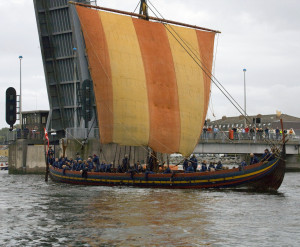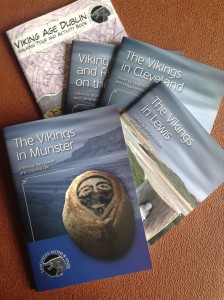Unlocking the Vikings

The reconstructed Viking ship, Sea Stallion, the subject of Tom Birkett’s paper at the Unlocking the Vikings conference, sails into Dublin, 14 August 2007.
(Image adapted under the Creative Commons Attribution-ShareAlike 2.0 Generic licence from an original photo by William Murphy.)
2014 is turning out to be the year of the Norsemen! As well as visiting the Vikings: Life and Legend exhibition at the British Museum and attending the Midlands Viking Symposium in the spring, last weekend I took time out from working on my latest novel-in-progress to go to the Unlocking the Vikings conference at the University of Nottingham.
In common with last year’s The Middle Ages in the Modern World at the University of St Andrews, the focus of the two-day event was as much upon the various ways in which the Viking Age has been represented in modern culture as it was upon the history itself. There were so many excellent papers and presentations – too many to mention individually – but I’ve chosen some of what, for me, were the highlights of the weekend.
The first session of the conference focussed on the Vikings in fiction, something of great interest to me since the Norsemen feature prominently both in Tancred’s saga and in the wider story of the Norman Conquest. Historian and novelist VM Whitworth (University of the Highlands and Islands) spoke about developing Viking Age characters, and the need for authors to fully immerse themselves in the thought-world of their creations. Ruarigh Dale (University of Nottingham) discussed portrayals of berserkers in current fiction, and how modern concepts compare with the original descriptions of these warriors in the Norse sagas.

The findings of the Languages, Myths and Finds project were brought together in these five beautifully produced booklets.
The conference also marked the conclusion of the Languages, Myths and Finds project, which aimed to investigate how Norse heritage and culture continue to make an impact in the twenty-first century, and the ways in which the Viking past is remembered and celebrated in Dublin, Munster, the Isle of Man, the Hebrides and Cleveland. Each of the regional teams presented their findings, which included the dramatic reveal by the Cleveland researchers of a previously unknown Viking runestone – an especially exciting discovery since, in contrast to Scandinavia, so few have been found in England.
As well as giving presentations at the conference, the teams also produced a series of booklets containing the findings of their research (pictured, above left): one for each of the five regions explored in the study. The booklets can also be downloaded in PDF form from the Languages, Myths and Finds website, where you can also find out more about the project and its aims. The video below from the University of Nottingham also gives a brief introduction.
Other highlights from the conference included a skaldic performance by Thor Ewing, featuring music on reconstructed Viking Age harp and flute, and a paper by Tom Birkett (University College Cork) on his experiences aboard the Sea Stallion – a reconstructed Viking ship based on the remains of Skuldelev 2, an eleventh-century vessel excavated at Roskilde, Denmark in 1962.
As always with these events, I came away brimming with ideas and armed with several pages of notes, furiously scribbled during the various talks and presentations. And who knows? Somewhere in all those notes might lie the inspiration for a future novel or two…


















